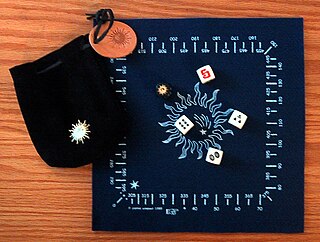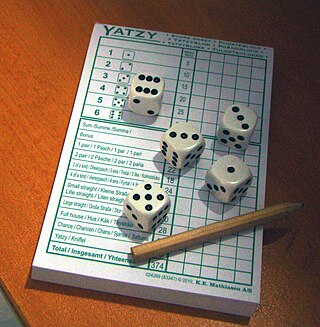This article needs additional citations for verification .(May 2017) |

Midnight (or 1-4-24) is a dice game played with six dice.
This article needs additional citations for verification .(May 2017) |

Midnight (or 1-4-24) is a dice game played with six dice.
One player rolls at a time. All six dice are rolled; the player must "keep" at least one. Any that the player doesn't keep are rerolled. This procedure is then repeated until there are no more dice to roll. Once kept, dice cannot be rerolled. Players must have kept a 1 and a 4, or they do not score. If they have a 1 and 4, the other dice are totaled to give the player's score. The maximum score is 24 (four 6s.) The procedure is repeated for the remaining players. The player with the highest four-dice total wins. [1]
If two or more players tie for the highest total, any money bet is added to the next game.
Dice shown in black are those kept from a previous roll.
| Roll | Dice | Keep |
|---|---|---|
| 1 | | |
| 2 | | |
| 3 | | |
| 4 | | |
The player scores 20 (6+3+5+6).
A variant version, called 2-4-24, in which the player must keep a 2 and a 4 to score, rather than a 1 and a 4, is sometimes played.[ citation needed ]
It is possible to calculate the probability of scoring if that is the player's sole objective. This would, for instance, be the case if the player was the last to throw and the other players had not scored.
The strategy is to keep a 1 or a 4 when they are first thrown and otherwise to keep just one die, as required by the rules. Playing this strategy will mean that the player will score unless they fail to throw a 1 or a 4 in 21 (=6+5+4+3+2+1) throws of the dice. This is because the only time a player will keep two dice is when they are 1 and 4, in which the player is guaranteed to score. Since 21 is the maximum number of throws possible, this strategy must maximise the chance of scoring. The probability of scoring is where is the number of dice thrown; in this case 21. This comes from applying the inclusion–exclusion principle to the 3 cases of failure: you never get any 1s with probability , you never get any 4s with probability , and you never get any 1s or 4s with probability . Plugging in gives the chance of scoring as approximately 95.7%, the maximum possible.
The formula can also be used to calculate the probability of having a 1 and a 4 after each throw when using this strategy.
| Number of dice thrown | Probability |
|---|---|
| 6 | 41.8% |
| 5 | 74.2% |
| 4 | 87.2% |
| 3 | 92.6% |
| 2 | 94.8% |
| 1 | 95.7% |
So the player has a 41.8% chance of throwing a 1 and a 4 on the first throw of the dice and a 74.2% chance of throwing a 1 and a 4 after the second throw of the dice.
The formula can be used to calculate the maximum probability of scoring when the player has less than 6 dice.
| Number of dice left | With neither a 1 nor a 4 | With either a 1 or a 4 |
|---|---|---|
| 6 | 95.7% | – |
| 5 | 87.2% | 93.5% |
| 4 | 69.4% | 83.8% |
| 3 | 41.8% | 66.5% |
| 2 | 13.9% | 42.1% |
| 1 | 0.0% | 16.7% |
So the player has an 87.2% chance of scoring even when they only have 5 dice left and they have not kept a 1 or a 4 on the first throw. They have a 93.5% chance of scoring at this stage if they kept a 1 or 4 on the first throw. When a player hasn't kept either a 1 or a 4 and has only 2 dice left, the chance of getting a 1 and 4 with these 2 dice is 13.9%.

Craps is a dice game in which players bet on the outcomes of the roll of a pair of dice. Players can wager money against each other or against a bank. Because it requires little equipment, "street craps" can be played in informal settings. While shooting craps, players may use slang terminology to place bets and actions.
A statistical model is a mathematical model that embodies a set of statistical assumptions concerning the generation of sample data. A statistical model represents, often in considerably idealized form, the data-generating process. When referring specifically to probabilities, the corresponding term is probabilistic model. All statistical hypothesis tests and all statistical estimators are derived via statistical models. More generally, statistical models are part of the foundation of statistical inference. A statistical model is usually specified as a mathematical relationship between one or more random variables and other non-random variables. As such, a statistical model is "a formal representation of a theory".

Hazard is an early English game played with two dice; it was mentioned in Geoffrey Chaucer's Canterbury Tales in the 14th century.
The principle of indifference is a rule for assigning epistemic probabilities. The principle of indifference states that in the absence of any relevant evidence, agents should distribute their credence equally among all the possible outcomes under consideration.

Yahtzee is a dice game made by Milton Bradley. It was first marketed under the name of Yahtzee by game entrepreneur Edwin S. Lowe in 1956. The game is a development of earlier dice games such as Poker Dice, Yacht and Generala. It is also similar to Yatzy, which is popular in Scandinavia.
In statistics, gambler's ruin is the fact that a gambler playing a game with negative expected value will eventually go broke, regardless of their betting system.

Pig is a simple dice game first described in print by John Scarne in 1945. Players take turns to roll a single die as many times as they wish, adding all roll results to a running total, but losing their gained score for the turn if they roll a 1.
Liar's dice is a class of dice games for two or more players requiring the ability to deceive and to detect an opponent's deception. In "single hand" liar's dice games, each player has a set of dice, all players roll once, and the bids relate to the dice each player can see plus all the concealed dice. In "common hand" games, there is one set of dice which is passed from player to player. The bids relate to the dice as they are in front of the bidder after selected dice have been re-rolled. Originating during the 15th century, the game subsequently spread to Latin American and European countries. In 1993, a variant, Call My Bluff, won the Spiel des Jahres.

Cee-lo is a gambling game played with three six-sided dice. There is not one standard set of rules, but there are some constants that hold true to all sets of rules. The name comes from the Chinese Sì-Wŭ-Liù (四五六), meaning "four-five-six". In America it is also called "See-Low," "Four-Five-Six," "The Three Dice Game," "Roll-off!," and by several alternative spellings, as well as simply "Dice." In China it is also called "Sān Liù Bàozi" (三六豹子), or "Three-Six Leopards". In Japan, it is known as "Chinchiro" (チンチロ) or "Chinchirorin" (チンチロリン).
Farkle, or Farkel, is a dice game similar to or synonymous with 1000/5000/10000, Cosmic Wimpout, Greed, Hot Dice, Squelch, Zilch, or Zonk. Its origins as a folk game are unknown, but the game dates back to at least the mid-1980s. It has been marketed commercially since 1996 under the brand name Pocket Farkel by Legendary Games Inc. While the basic rules are well-established, there is a wide range of variation in both scoring and play.

Chowka Bara or Ashta Chamma is a two- or four-player board game from India. This game is an example of a “fully observable” system that has an element of chance introduced by the roll of special dice and an element of strategy. While traditionally played with 4 or 6 cowry shells, dice can also be used.
A set of dice is intransitive if it contains three dice, A, B, and C, with the property that A rolls higher than B more than half the time, and B rolls higher than C more than half the time, but where it is not true that A rolls higher than C more than half the time. In other words, a set of dice is intransitive if the binary relation – X rolls a higher number than Y more than half the time – on its elements is not transitive. More simply, A normally beats B, B normally beats C, but A does not normally beat C.

Cosmic Wimpout is a dice game produced by C3, Inc in 1976. It is similar to 1000/5000/10000, Farkle, Greed, Hot Dice, Squelch, Zilch, to name but a few. The game is played with five custom dice, and may use a combination score board and rolling surface, in the form of a piece of cloth or felt available in various colors and designs. Players supply their own game piece for score keeping.
Dice notation is a system to represent different combinations of dice in wargames and tabletop role-playing games using simple algebra-like notation such as d8+2.

Ship, Captain, and Crew is a drinking game played with five dice. The game can be played with as few as two people, but is usually played in a group of five or more. The object of the game is to roll a six, a five ("captain"), and a four ("crew") with three dice, and get the highest score with the other two dice. In other versions, a four is the "mate" and the remaining dice are the crew.

Yatzy is a dice game similar to Yacht and Yahtzee. It is related to the Latin American game Generala and the English game of poker dice. Yatzy is most popular in the Nordic countries.
The mathematics of gambling is a collection of probability applications encountered in games of chance and can get included in game theory. From a mathematical point of view, the games of chance are experiments generating various types of aleatory events, and it is possible to calculate by using the properties of probability on a finite space of possibilities.

Generala is a dice game similar to the English game of poker dice, the German game Kniffel, and the Polish game Jacy-Tacy (yahtzee-tahtzee). The American variant of Generala, Yahtzee, is the most popular variant. Although it is sometimes played in Europe and the United States, Generala is most popular in Ibero-America.

Miwin's Dice are a set of nontransitive dice invented in 1975 by the physicist Michael Winkelmann. They consist of three different dice with faces bearing numbers from one to nine; opposite faces sum to nine, ten or eleven. The numbers on each die give the sum of 30 and have an arithmetic mean of five.
In decision theory, the odds algorithm is a mathematical method for computing optimal strategies for a class of problems that belong to the domain of optimal stopping problems. Their solution follows from the odds strategy, and the importance of the odds strategy lies in its optimality, as explained below.